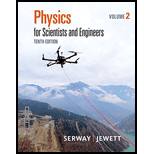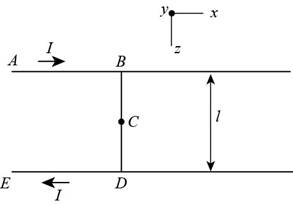
Concept explainers
Review. Rail guns have been suggested for launching projectiles into space without chemical rockets. A tabletop model rail gun (Fig. P29.42) consists of two long, parallel, horizontal rails ℓ = 3.50 cm apart, bridged by a bar of mass m = 3.00 g that is free to slide without friction. The rails and bar have low electric resistance, and the current is limited to a constant I = 24.0 A by a power supply that is far to the left of the figure, so it has no magnetic effect on the bar. Figure P29.42 shows the bar at rest at the midpoint of the rails at the moment the current is established. We wish to find the speed with which the bar leaves the rails after being released from the midpoint of the rails. (a) Find the magnitude of the magnetic field at a distance of 1.75 cm from a single long wire carrying a current of 2.40 A. (b) For purposes of evaluating the magnetic field, model the rails as infinitely long. Using the result of part (a), find the magnitude and direction of the magnetic field at the midpoint of the bar. (c) Argue that this value of the field will be the same at all positions of the bar to the right of the midpoint of the rails. At other points along the bar, the field is in the same direction as at the midpoint, but is larger in magnitude. Assume the average effective magnetic field along the bar is five times larger than the field at the midpoint. With this assumption, find (d) the magnitude and (e) the direction of the force on the bar. (f) Is the bar properly modeled as a particle under constant acceleration? (g) Find the velocity of the bar after it has traveled a distance d = 130 cm to the end of the rails.
Figure P29.42

(a)
Answer to Problem 42AP
Explanation of Solution
Given info: The length of the rails is
Formula to calculate the magnetic field is
Here,
Substitute
Conclusion:
Therefore, the magnitude of the magnetic field at a distance of
(b)
Answer to Problem 42AP
Explanation of Solution
Given info: The length of the rails is
The diagram that represents the given situation is shown below.

Figure (I)
Since the current is diverted through the bar, only half of each rails carries currents, so the field produce by each rail is half of the infinitely long wire produces.
Write the expression for the magnetic field produce by conductor AB at point C is,
Substitute
Write the expression for the magnetic field produce by conductor DE at point C is,
Substitute
Formula to calculate the total magnetic field at point C is,
Substitute
Conclusion:
Therefore, the magnitude of the magnetic field at the mid-point of the bar is
(c)
Answer to Problem 42AP
Explanation of Solution
Given info: The length of the rails is
The assumption makes that the rails are infinitely long so, the length of the rail to the right of the bar does not depend upon the location of the bar. Hence the magnetic field will be same at all position of the bar to the right of the midpoint of the rails.
Conclusion:
Therefore, due to infinite length of the rails makes the field same at all position of the midpoint of the bar.
(d)
Answer to Problem 42AP
Explanation of Solution
Given info: The length of the rails is
Formula to calculate the force on the bar is,
Here,
Substitute
Conclusion:
Therefore, the magnitude of the force on the bar is
(e)
Answer to Problem 42AP
Explanation of Solution
Given info: The length of the rails is
The force vector on the bar is
Conclusion:
Therefore, the direction of the force on the bar is in positive x-direction.
(f)
Answer to Problem 42AP
Explanation of Solution
Given info: The length of the rails is
The length of the bar, value of current and field producer is constant so, the force exerted on the bar is constant that gives uniform acceleration of the bar.
Formula to calculate the acceleration of the bar is,
Substitute
Conclusion:
Therefore, the bar will move with constant acceleration of magnitude
(g)
Answer to Problem 42AP
Explanation of Solution
Given info: The length of the rails is
Formula to calculate the velocity of the bar is,
Here,
Substitute
Conclusion:
Therefore, the velocity of the bar is
Want to see more full solutions like this?
Chapter 29 Solutions
Physics for Scientists and Engineers, Volume 2
- pls help on all asked questions kindlyarrow_forward19. Mount Everest, Earth's highest mountain above sea level, has a peak of 8849 m above sea level. Assume that sea level defines the height of Earth's surface. (re = 6.38 × 106 m, ME = 5.98 × 1024 kg, G = 6.67 × 10 -11 Nm²/kg²) a. Calculate the strength of Earth's gravitational field at a point at the peak of Mount Everest. b. What is the ratio of the strength of Earth's gravitational field at a point 644416m below the surface of the Earth to a point at the top of Mount Everest? C. A tourist watching the sunrise on top of Mount Everest observes a satellite orbiting Earth at an altitude 3580 km above his position. Determine the speed of the satellite.arrow_forwardpls help on allarrow_forward
- pls help on allarrow_forward6. As the distance between two charges decreases, the magnitude of the electric potential energy of the two-charge system: a) Always increases b) Always decreases c) Increases if the charges have the same sign, decreases if they have the opposite signs d) Increases if the charges have the opposite sign, decreases if they have the same sign 7. To analyze the motion of an elastic collision between two charged particles we use conservation of & a) Energy, Velocity b) Momentum, Force c) Mass, Momentum d) Energy, Momentum e) Kinetic Energy, Potential Energyarrow_forwardpls help on all asked questions kindlyarrow_forward
- pls help on all asked questions kindlyarrow_forward17. Two charges, one of charge +2.5 × 10-5 C and the other of charge +3.7 × 10-6 C, are 25.0 cm apart. The +2.5 × 10−5 C charge is to the left of the +3.7 × 10−6 C charge. a. Draw a diagram showing the point charges and label a point Y that is 20.0 cm to the left of the +3.7 × 10-6 C charge, on the line connecting the charges. (Field lines do not need to be drawn.) b. Calculate the net electric field at point Y.arrow_forward3arrow_forward
 Principles of Physics: A Calculus-Based TextPhysicsISBN:9781133104261Author:Raymond A. Serway, John W. JewettPublisher:Cengage Learning
Principles of Physics: A Calculus-Based TextPhysicsISBN:9781133104261Author:Raymond A. Serway, John W. JewettPublisher:Cengage Learning Physics for Scientists and Engineers: Foundations...PhysicsISBN:9781133939146Author:Katz, Debora M.Publisher:Cengage Learning
Physics for Scientists and Engineers: Foundations...PhysicsISBN:9781133939146Author:Katz, Debora M.Publisher:Cengage Learning Physics for Scientists and Engineers with Modern ...PhysicsISBN:9781337553292Author:Raymond A. Serway, John W. JewettPublisher:Cengage Learning
Physics for Scientists and Engineers with Modern ...PhysicsISBN:9781337553292Author:Raymond A. Serway, John W. JewettPublisher:Cengage Learning College PhysicsPhysicsISBN:9781938168000Author:Paul Peter Urone, Roger HinrichsPublisher:OpenStax College
College PhysicsPhysicsISBN:9781938168000Author:Paul Peter Urone, Roger HinrichsPublisher:OpenStax College College PhysicsPhysicsISBN:9781285737027Author:Raymond A. Serway, Chris VuillePublisher:Cengage Learning
College PhysicsPhysicsISBN:9781285737027Author:Raymond A. Serway, Chris VuillePublisher:Cengage Learning Physics for Scientists and EngineersPhysicsISBN:9781337553278Author:Raymond A. Serway, John W. JewettPublisher:Cengage Learning
Physics for Scientists and EngineersPhysicsISBN:9781337553278Author:Raymond A. Serway, John W. JewettPublisher:Cengage Learning





